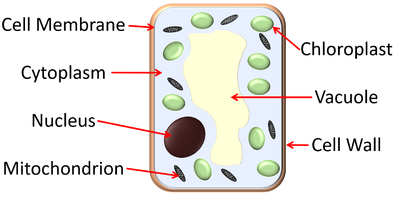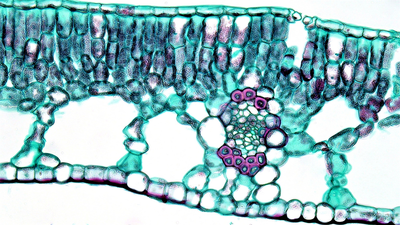Difference between revisions of "Plant Cell"
(→About Plant Cells) |
(→About Plant Cells) |
||
| Line 43: | Line 43: | ||
|} | |} | ||
| − | : There are several specialised plant cells that you should know: | + | : There are several [[Specialised Plant Cell|specialised plant cells]] that you should know: |
*[[Palisade Cell]] | *[[Palisade Cell]] | ||
*[[Spongy Mesophyll Cell]] | *[[Spongy Mesophyll Cell]] | ||
Revision as of 18:26, 11 June 2019
Contents
Key Stage 3
Meaning
A plant cell is a cell that has a cell membrane, cell wall, cytoplasm, mitochondria, chloroplasts, a permanent vacuole and a nucleus.
About Plant Cells
- Plant cells have more parts than an animal cell.
| A diagram of a typical plant cell. |
- There are several specialised plant cells that you should know:
Examples
| This leaf cross section shows palisade cells are the second from the top, spongy mesophyll cells in the middle, two guard cells at the top and some xylem cells surrounded by purple stained cells. |
Key Stage 4
Meaning
A plant cell is a eukaryotic cell that has a cell membrane, cell wall, cytoplasm, mitochondria, chloroplasts, a permanent vacuole and a nucleus.
About Plant Cells
- As a eukaryotic cell a plant cell contains membrane bound organelles, including a nucleus, several mitochondria and a permanent vacuole.
- Plant cells can be distinguished from animal cells in that they have a cell wall made of cellulose, a permanent vacuole and may have chloroplasts (depending on where those cells are in the plant).
- Plant cells can store starch in the cytoplasm, which is shown when they are dyed with Iodine solution prior to being viewed under a light microscope.
| A diagram of a typical plant cell. |
- There are several specialised plant cells that you should know:
Examples
| This leaf cross section shows palisade cells are the second from the top, spongy mesophyll cells in the middle, two guard cells at the top and some xylem cells surrounded by phloem cells. |

